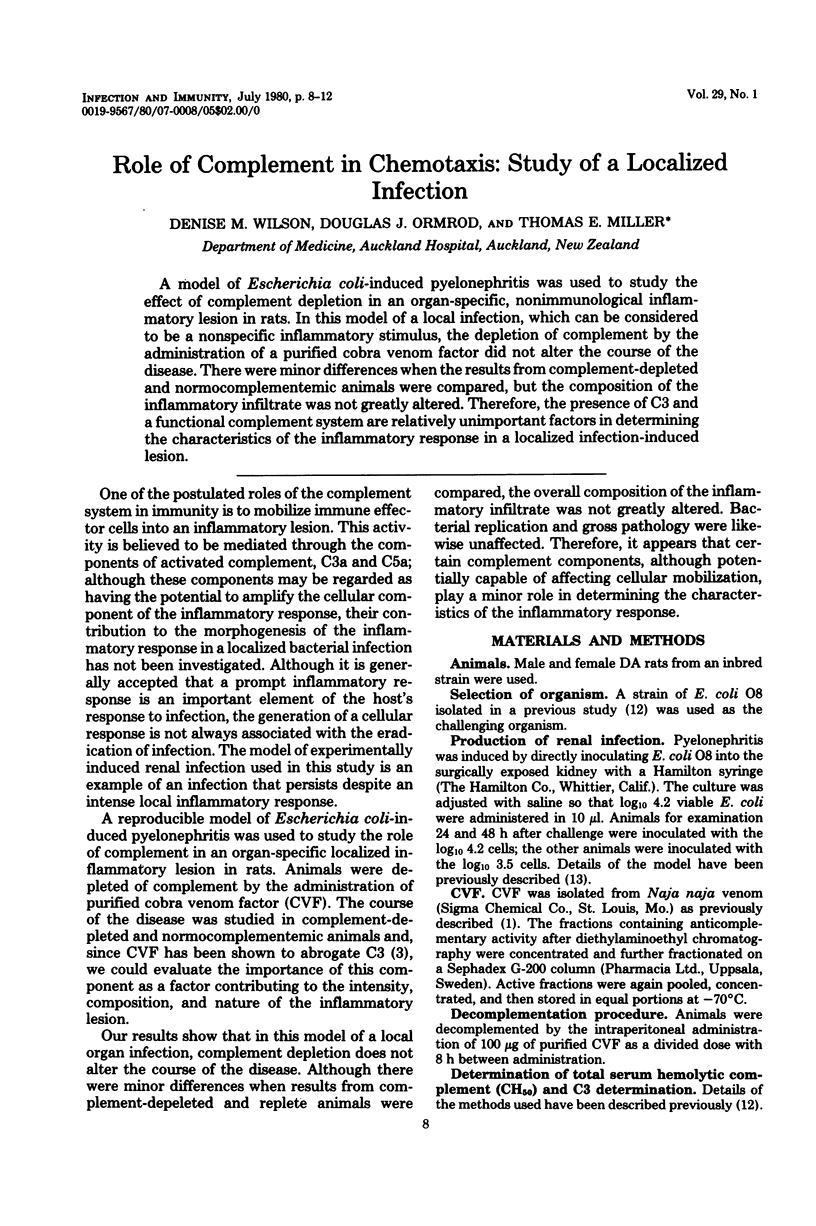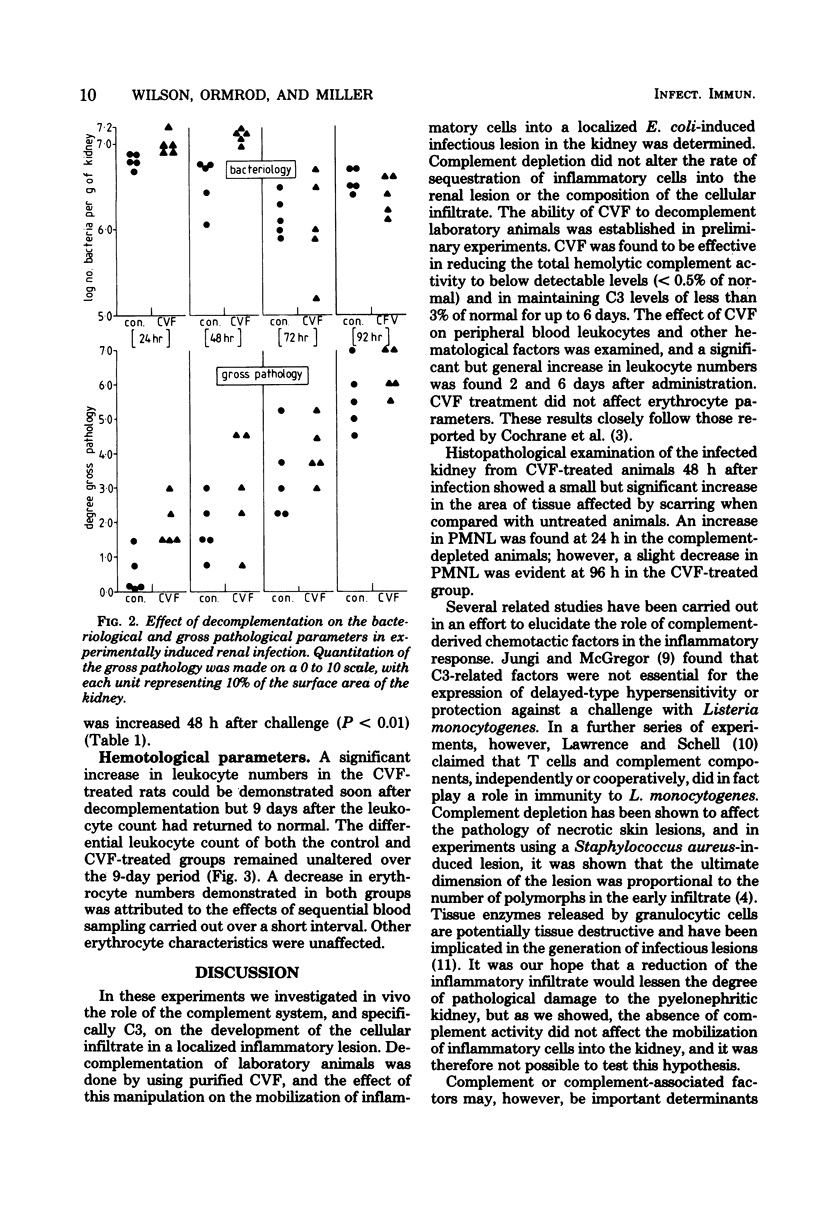Abstract
A model of Escherichia coli-induced pyelonephritis was used to study the effect of complement depletion in an organ-specific, nonimmunological inflammatory lesion in rats. In this model of a local infection, which can be considered to be nonspecific inflammatory stimulus, the depletion of complement by the administration of a purified cobra venom factor did not alter the course of the disease. There were minor differences when the results from complement-depleted and normocomplementemic animals were compared, but the composition of the inflammatory infiltrate was not greatly altered. Therefore, the presence of C3 and a functional complement system are relatively unimportant factors in determining the characteristics of the inflammatory response in a localized infection-induced lesion.
Full text
PDF




Selected References
These references are in PubMed. This may not be the complete list of references from this article.
- Ballow M., Cochrane C. G. Two anticomplementary factors in cobra venom: hemolysis of guinea pig erythrocytes by one of them. J Immunol. 1969 Nov;103(5):944–952. [PubMed] [Google Scholar]
- Cochrane C. G., Müller-Eberhard H. J., Aikin B. S. Depletion of plasma complement in vivo by a protein of cobra venom: its effect on various immunologic reactions. J Immunol. 1970 Jul;105(1):55–69. [PubMed] [Google Scholar]
- Easmon C. S., Glynn A. A. Comparison of subcutaneous and intraperitoneal staphylococcal infections in normal and complement-deficient mice. Infect Immun. 1976 Feb;13(2):399–406. doi: 10.1128/iai.13.2.399-406.1976. [DOI] [PMC free article] [PubMed] [Google Scholar]
- Fernandez H. N., Henson P. M., Otani A., Hugli T. E. Chemotactic response to human C3a and C5a anaphylatoxins. I. Evaluation of C3a and C5a leukotaxis in vitro and under stimulated in vivo conditions. J Immunol. 1978 Jan;120(1):109–115. [PubMed] [Google Scholar]
- Goldstein I. M. Editorial: Endogenous regulation of complement (C5)-derived chemotactic activity: fine-tuning of inflammation. J Lab Clin Med. 1979 Jan;93(1):13–16. [PubMed] [Google Scholar]
- Gross G. N., Rehm S. R., Pierce A. K. The effect of complement depletion on lung clearance of bacteria. J Clin Invest. 1978 Aug;62(2):373–378. doi: 10.1172/JCI109138. [DOI] [PMC free article] [PubMed] [Google Scholar]
- Jarvinen J. A., Dalmasso A. P. Trypanosoma musculi infections in normocomplementemic, C5-deficient, and C3-depleted mice. Infect Immun. 1977 May;16(2):557–563. doi: 10.1128/iai.16.2.557-563.1977. [DOI] [PMC free article] [PubMed] [Google Scholar]
- Jungi T. W., McGregor D. D. Role of complement in the expression of delayed-type hypersensitivity in rats: studies with cobra venom factor. Infect Immun. 1979 Mar;23(3):633–643. doi: 10.1128/iai.23.3.633-643.1979. [DOI] [PMC free article] [PubMed] [Google Scholar]
- Lawrence D. A., Schell R. F. Susceptibility of C5-deficient mice to listeriosis: modulation by Concanavalin A. Cell Immunol. 1978 Sep;39(2):336–344. doi: 10.1016/0008-8749(78)90109-0. [DOI] [PubMed] [Google Scholar]
- Leffell M. S., Spitznagel J. K. Intracellular and extracellular degranulation of human polymorphonuclear azurophil and specific granules induced by immune complexes. Infect Immun. 1974 Dec;10(6):1241–1249. doi: 10.1128/iai.10.6.1241-1249.1974. [DOI] [PMC free article] [PubMed] [Google Scholar]
- Miller T. E., Phillips S., Simpson I. J. Complement-mediated immune mechanisms in renal infection. II. Effect of decomplementation. Clin Exp Immunol. 1978 Jul;33(1):115–121. [PMC free article] [PubMed] [Google Scholar]
- Miller T. E., Robinson K. B. Experimental pyelonephritis: a new method for inducing pyelonephritis in the rat. J Infect Dis. 1973 Mar;127(3):307–310. doi: 10.1093/infdis/127.3.307. [DOI] [PubMed] [Google Scholar]
- Rother K. Leucocyte mobilizing factor: a new biological activity derived from the third component of complement. Eur J Immunol. 1972 Dec;2(6):550–558. doi: 10.1002/eji.1830020615. [DOI] [PubMed] [Google Scholar]
- TALIAFERRO W. H., TALIAFERRO L. G. The dynamics of hemolysin formation in intact and splenectomized rabbits. J Infect Dis. 1950 Jul-Aug;87(1):37–62. doi: 10.1093/infdis/87.1.37. [DOI] [PubMed] [Google Scholar]


